![]()
![]()
![]()
Use LEFT and RIGHT arrow keys to navigate between flashcards;
Use UP and DOWN arrow keys to flip the card;
H to show hint;
A reads text to speech;
20 Cards in this Set
- Front
- Back
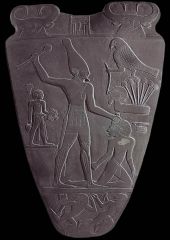
|
Pallette of King Narmer (Front), From Hierakonpolis. ca. 3150-3125 BCE -King Narmer wears the White Crown of Upper Egypt -King Raising his Mace/ Emblem of Kingship -Composite View/ Hallmark of Egyptian 2D Art Frontal View: Eye, shoulders, arms Profile View: Head, legs -Hieratic scale, bull tail, heads of cows |
|
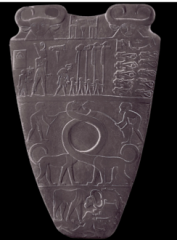
|
Pallette of King Narmer (Back), From Hierakonpolis. ca. 3150-3125 BCE -King Narmer wears the Red Crown of Lower Egypt -Twisted Animal Necks -Bull Trampling People |
|
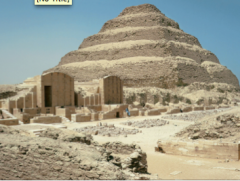
|
Imhotep. Step pyramid and funerary complex of King Djoser, Saqqara. 3rd Dynasty. ca. 2681-2662 BCE Old Kingdom - First Known Major Funerary Complex -Started as a Mastaba -Imitates design of palace, palace-perishable material Funerary complex-stone -Columns imitate: papyrus stems, reed bundles, capitals resemble Blossoms |
|
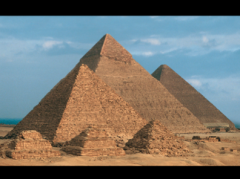
|
The pyramids of Menkaure, ca. 2533-2515 BCE, Khafra, ca. 2570-2544 BCE and Khufu, ca. 2601-2528 BCE, Giza Khufu - Largest, Oldest Khafra- Middle, Middle Menkaure- Smallest, Newest |
|
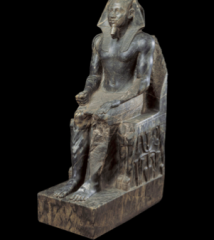
|
Khafra, from Giza. ca. 2500 BCE -Upright Rigid Pose -Frontal, Compact, Solid, Block-like -Expresses: Strength, permanence Muscle = Power Ageless= Eternal |
|
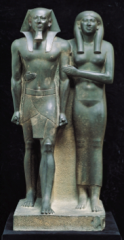
|
Menkaure and his Wife, Queen Khamererenbty II, from Giza. Ca. 2115 BCE - Menkaure Wears Royal Dress- Kilt, Nemes Headdress, False Beard -Athletic -Typical Balanced Pose Other qualities similar to Khafra |
|

|
Relief Panel of Hesy-ra, from Saqqara. ca. 2660 BCE -Composite View -Stance of Royal/Elite -1st Ideal Image of Elite Male -Youthful. Physically Fit. Ageless |
|

|
Grid showing proportional guidelines for relief panel of Hesy-ra The Canon - Body proportions are consistent, suggests set of guidelines- canon -set rules -Began 5th Dynasty |
|
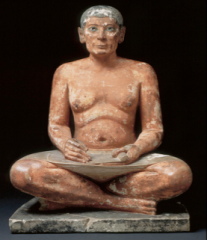
|
Seated Scribe, from Saqqara. ca. 2400 BCE -2nd Ideal Image of Elite Males - Maturity- Sign of Age, Rolls, Slack Muscles, Sagging Jaw - Rigid -Upright - Frontal |
|

|
Senwosret III. ca. 1850 BCE -Middle Kingdom -Facial Expressions more naturalistic -Reflect stress -Weight of Responsibilities -Emotionally Drained -Eyelids Droop and bags under eyes |
|

|
Lady Sennuwy, ca. 1920 BCE -Proportions Also Change -Narrower Shoulders and Waist -Slimmer Limbs |
|
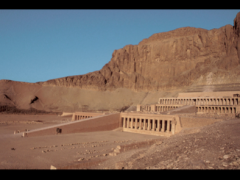
|
Temple of Hatshepsut, Deir el-Bahri. ca. 1478-1458 BCE -New Kingdom -Change in Burial Practices |
|
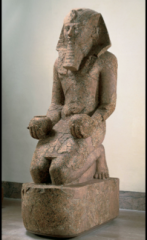
|
Kneeling Figure of King Hatshepsut, from Deir el-Bahri. ca. 1473-1458 BCE - Female King -Wears King's Dress, No breasts |
|
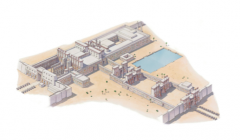
|
Reconstruction drawing of Temple of Amun-Ra, Karnak, Thebes |
|
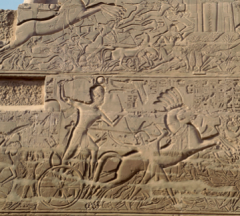
|
Seti I's Campaigns, Temple of Amun-Ra, Karnak, Thebes (Exterior wall, north side of hypostyle hall). ca. 1280 BCE -Sunken Relief |
|

|
Temple of Ramesses II, Abu Simbel. 19th Dynasty. ca. 1279-1213 BCE |
|
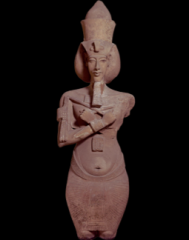
|
Akhenaten, from Karnak, Thebes. 1353-1335 BCE - The Amarna Style |
|
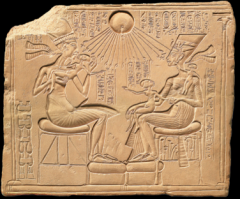
|
Akhenaten and His Family. ca. 1355 BCE -Amarna Style - Naturalistic, not only for kings, intimate scene |
|

|
Queen Nefertiti. ca. 1348-1336/35 BCE |
|
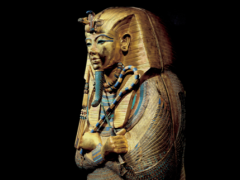
|
Cover of the coffin of Tutankhamun. 18th Dynasty |

